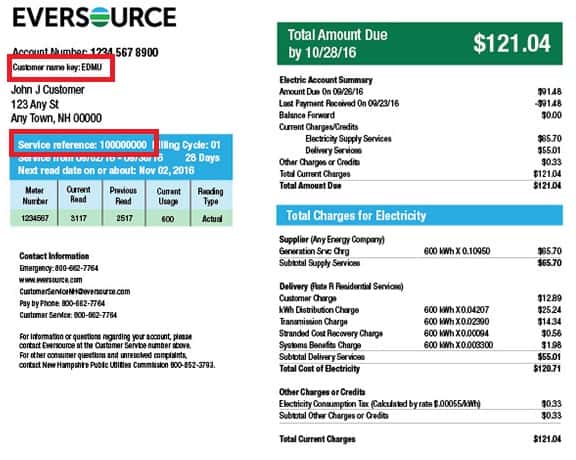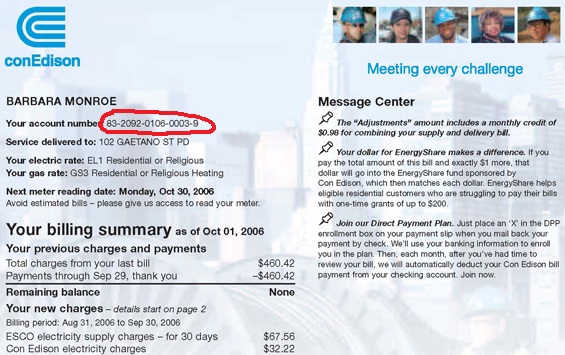
Home
Business
Con Edison bills are sub-divided into a few sections showing your account and address information, historical usage, and delivery and supply charges. Account information, address, and historical usage are generally displayed on the first page and are clearly marked. The breakdown presenting different components of supply and delivery charges is displayed on pages 2-3 of the utility bill. This is the most important section of the bill, and should be analysed carefully. Below we present a sample bill highlighting variable supply and delivery charges that incurred during a month.
Highlighted sections are as follows:
The Red squares show specific areas of the bill, you should pay close attention to. They also describe how to calculate the actual variable supply rate charged by your utility, and use it as a starting point when shopping for offers from alternative energy suppliers.
Red and Green break down your supply and delivery charges into market price, the actual price you paid to Jersey Central Power & Light for the electricity or gas delivered to your home, including various fees and surcharges.
While the delivery expense cannot be avoided, supply cost can be lowered if you switch energy supplier. With fixed-term rates provided by alternative energy suppliers there are no fluctuations in monthly price per kWh, no extra fees or surcharges, and no interruption of service. Additionally, by locking in a particular rate you can lower your energy bill, as some fluctuations could be extreme. The chart below shows average historical supply rates for Con Edison. Clearly, electricity prices can jump to extreme levels in a short period of time, causing significant increase in energy charges. To avoid that a lot of consumers already switched to an alternative power supplier, saving time and money! Try our comparison tool and see if you can save too!
© PowerSetter.com. All rights reserved.
![]() Green energy choices available
Green energy choices available
Direct Energy is one of North America’s largest retail providers of electricity, natural gas and home and business energy-related services.
The North American Headquarters are located in Houston, Texas, with regional offices across the U.S. and Canada, Direct Energy operates in 50 US states, the District of Columbia and eight Canadian provinces.
Direct Energy offers peace of mind with fixed competitive rates, transparent pricing and great customer service. Their wide range of products include customized electricity plans, fixed-rate plans, renewable energy plans, and more.
SmartEnergy is an independent energy supplier committed to providing customers with reliable electricity from 100% renewable resources. SmartEnergy purchases renewable energy credits (RECs) to offset 100% of your electricity usage and seeks to provide real value to our customers. Their renewable sources include solar, wind, hydroelectric, and geothermal energy, making us a cleaner option for both your home and our planet. Since 2012, they have been committed to helping customers choose the environmentally friendly option when it comes to their electricity supply.
Catalyst Power is an integrated provider of commercial energy, Connected Microgrid solutions, and Community Solar. Their supply options help your business save money, reduce environmental impact, and maintain power. Literally.
Catalyst Power develops innovative energy supply solutions for commercial and industrial companies, with a focus on a first-of-its-kind network of Connected Microgrids using onsite solar panels and batteries, as well as retail power and gas supply. By leveraging their extensive energy industry experience, Catalyst Power provides small- to industrial-sized businesses access to distributed generation through the network of Connected Microgrids.
Their goal is to identify, underwrite, fund, and provide greater opportunities to the customers while operating more cost-effective onsite energy projects for their retail energy clients. They accomplish this with a proprietary technology platform that gives them a fresh perspective on the data.
City Power and Gas is licensed and regulated by the governing body that regulates the energy rates and services within New York and Pennsylvania. Their core management team has over 50 years of industry knowledge and expertise in providing energy to customers nationwide. This experience in the retail energy markets has enabled them to bring the most competitive pricing and fixed pricing plans to the customers, giving them protection against unforeseen high utility bills. Their in-house, US based customer service and quality assurance specialists are dedicated to promptly respond and deal with all clients’ inquiries.
APG&E has been in the business to help customers save money on electricity since 2004. Competitive rates for Residential, Small Business and Commercial customers. Fixed Rate Plans that provide price certainty and peace of mind. Fast and easy to switch with no interruption in your electricity service.
Since 1997, Green Mountain Energy has been dedicated to changing the way power is made by offering 100% clean energy plans, carbon offsets and sustainable living solutions. Today, as the nation’s longest-serving renewable energy retailer, Green Mountain Energy is more committed than ever to helping customers achieve their green lifestyle for the long term.
Founded in 2008, Frontier Utilities is a retail electric and gas provider serving deregulated Texas, New Jersey, Pennsylvania, Ohio and Illinois; dedicated to providing honest and innovative electricity solutions for both residential and commercial customers. They offer a wide variety of plan options that serve different needs of their customers.
Great Eastern Energy is a leading supplier of natural gas, electricity and renewable energy in the Northeast. Founded in 1996, they remain one of the longest standing alternative energy companies in the region. Their full service energy solutions help businesses and property owners thrive by managing their energy costs and increasing their bottom-line.
Today they lead the industry with thorough understanding of the energy market. By staying on top of the latest energy trends, they are able to bring the best energy services and technology to their customers. Great Eastern Energy takes pride in providing transparent solutions and building trusting relationships.
Their mission is to empower people with the knowledge necessary to make better energy decisions. They are at the forefront of the sustainability movement and are focused on promoting positive energy behaviors and reducing consumption.
Founded in 2008, Public Power is one of the largest licensed electricity and gas suppliers in the U.S. Public Power is headquartered in Connecticut, and is also licensed to offer similar services in Illinois, Maryland, Massachusetts, New York, Ohio, Pennsylvania, Rhode Island and Washington, D.C. Focused on being the best and the most conscientious customer service company in the industry, Public Power provides services to hundreds of thousands residential and commercial customers. With the deregulation of electricity and gas in many states, Public Power gives people a choice for their energy provider.
Spark Energy, Inc. is an established and growing independent retail energy services company founded in 1999 that provides residential and commercial customers in competitive markets across the United States with an alternative choice for their natural gas and electricity. Headquartered in Houston, Texas, Spark currently operates in 19 states and serves 94 utility territories. Spark offers its customers a variety of product and service choices, including stable and predictable energy costs and green product alternatives.
Just Energy is a leading independent energy supplier with over 1.6 million electricity and natural gas customer accounts across the US and Canada. Just Energy’s business involves the sale of natural gas and electricity to residential and commercial customers under long-term fixed-price or price-protected contracts (price protected for electricity). By securing the price for natural gas or electricity under such contracts for a period of up to five years, Just Energy’s customers reduce or eliminate their exposure to changes in the price of these essential commodities.
Clearview Electric, Inc. began in 2006 as an electricity provider in Texas and is headquartered in Dallas. They enrolled their first customer in June 2007, and have experienced substantial growth in other markets. Clearview provides services to residents and small businesses in all deregulated electricity markets with plans to expand into all deregulated gas markets. Clearview offers fixed and variable rate products, including green energy plans that are 100% Renewable Energy. Clearview customers experience no interruption of service when switching and do not pay any start-up fees.
Provider of consumer technology platform designed to connect millions of users with clean, efficient and sustainable energy products. The company’s consumer technology platform leverages digital marketing tactics, including a multi-channel prospecting platform, to penetrate the massive retail energy sector, enabling consumers to access clean power that is good for their home and the environment.
Tomorrow Energy Corporation is a retail energy provider operating in multiple states across the country, including Illinois, Maryland, Ohio, New Jersey, New York and Pennsylvania. Tomorrow Energy focuses on exceptional service, innovative technology and competitive pricing in order to add value and provide exceptional service to their residential and commercial customers, both now and into the future. Tomorrow Energy Corporation is a subsidiary of the SNH Family of Companies, which provide a range of services to large financial institutions, Fortune 500 companies and consumers nationwide.
Founded in 2005, Infinite Energy offers great rates and award-winning, U.S.-based customer care, and serving most of New Jersey. They offer contracts anywhere from one month to up to five years. Infinite Energy offers flexible payment plans, managing accounts through online portal, customizing plans and services, and paying bills online. Infinite Energy also offers paperless billing and autopay options.
XOOM Energy through its family of companies is an independent retail electricity and natural gas provider in over 90 deregulated markets across the U.S. Its primary focus is on longer term traditional and renewable fixed-rate plans. It also offers fixed-payment options and billing flexibility.
Constellation is the nation’s largest producer of carbon-free energy and the leading competitive retail supplier of power and energy products and services for homes and businesses across the United States. Headquartered in Baltimore, our generation fleet powers more than 20 million homes and businesses and is helping to accelerate the nation’s transition to clean energy with more than 32,400 megawatts of capacity and annual output that is 90% carbon-free. Constellation has set a goal to eliminate 100% of its greenhouse gas emissions by 2040 by leveraging innovative technology and enhancing its diverse mix of hydro, wind and solar resources paired with the nation’s largest carbon-free nuclear fleet. Constellation’s family of retail businesses serves approximately 2 million residential, public sector and business customers, including three-fourths of the FORTUNE 100.
Think Energy is an electricity provider serving residential and commercial customers in Connecticut, D.C., Delaware, Illinois, Maine, Maryland, Massachusetts, New Hampshire, New Jersey, New York, Ohio, Pennsylvania, Rhode Island and Texas. It is one of the largest independent energy suppliers in the US, with its parent company Engie Resources named the No. 1 brand in the utilities sector for five consecutive years by Brand Finance Global 500. They offer unparalleled customer service, and bring vast experience in the energy field. Their offerings range from 6 to 24 months, and they offer both residential and commercial plans.
Verde Energy has been around for over 10 years and offers only 100% green energy. The company operates in 7 states, serves over 250,000 residential and commercial customers, and has 12-months contracts. Their renewable energy choices vary from wind to a mix of sources, and gives mindful consumers an option to support a preferred energy supply.
Veteran Energy has been in business since 2010, primarily serving those, who put everything on the line for this country. The company provides electricity for homes and businesses throughout Texas and gives back a portion of each customer’s bill to the veteran support organization of their choice. With Veteran Energy, customers get competitive electricity rates and exceptional customer care, all while supporting American military members.
Ambit Energy provides electricity and natural gas services in deregulated markets across the United States, primarily marketed through a direct sales channel of more than 250,000 Independent Consultants. Based in Dallas, Texas, our company is focused on being the finest and most-respected retail energy provider in America, offering cost-effective choices for today’s energy consumer. In 2010, Ambit was named #1 Fastest-Growing Private Company in America by Inc. magazine, and we continue to pick up steam as the fastest-growing company in the retail energy sector today.
Life Energy is an online energy retailer based in Houston, TX. Founded and created by a blend of industry vets and digital-savvy professionals who wanted to create a new type of energy company to give consumers a simpler, greener, and better option for residential and commercial electricity.
Vista Energy Marketing combines years of top-flight experience in the wholesale energy commodities market purchasing electricity and natural gas with a passion for people. With over 100,000 residential and commercial customers in nine different states, Vista Energy stands out from a crowded field of retail energy company by delivering competitive energy prices and innovative plans that will solve the energy needs of their customers.
Indra Energy is dedicated to providing electricity, natural gas, and renewable energy options to the millions of residential and commercial utility customers across 9 states and more than 64 utility markets. Indra’s leadership team has over 100 combined years of experience in the retail energy industry, providing customers with the security of knowing they are dealing with a group of people who have a proven track record. Company’s mission to make the enrollment process quick, easy and smooth.
4Change Energy, headquartered in the Dallas area, offers retail electricity in Texas at very competitive rates by having a simplified business model with primarily online services. Their mission is to be known for their low prices, enrollment without hassle, easy service you can trust, and helping Texans in great need. They set out to make a difference in the communities they serve by contributing 4% of annual profits to the local chapters of these established non-profits: American Cancer Society, American Red Cross, Heroes for Children and Feeding Texas.
Provider Power Mass is a New England founded, Competitive Electricity Supply company licensed to sell electricity directly to homes and businesses in Massachusetts. They are part of the Provider Power family of companies along with ENH Power and Electricity Maine.
Symmetry Energy Solutions, LLC is a leading energy supplier providing over 1 trillion cubic feet of natural gas to more than 100,000 customers in over 30 states. Symmetry Energy Solutions uses our wealth of experience to find new ways to help residential and business customers maximize their energy budgets every day. From comprehensive strategies and competitive pricing options to strong buying power and exceptional customer service, we strive to provide our customers with energy strategies that best fit their needs. That’s why, no matter the industry, we’re one of the most trusted energy partners in America — and why we’re proud to be a winner of the 2019 Mastio Quality Award.
ENH Power is a New England founded, Competitive Electricity Supply company licensed to sell electricity directly to homes and businesses in New Hampshire. We are part of the Provider Power family of companies along with Provider Power Mass and Electricity Maine.
Pulse Power is a Texas Electricity Retail Provider powered by Texans that know the deregulated electricity. They keep things simple so finding an electricity provider can be fast and easy. Their team works tirelessly to make sure they have the best available rates and solutions for the conscientious electricity shoppers.
Major Energy, based in Rockland County NY is one of the most highly regarded retail energy suppliers of natural gas & electricity. We serve residential and commercial customers in six states and more than 40 Utility Service Areas. We operate as Major Energy in Illinois, Maryland, Massachusetts and New York. We operate as Respond Power and Major Energy in New Jersey and Pennsylvania.
Respond Power, is an Energy Service Company (ESCO) serving residential and commercial customers in the deregulated electric markets of Pennsylvania and New Jersey. Now a Houston based company founded in 2005, Respond Power is familiar with the energy needs of our customers. Respond Power’s management has combined decades of experience in the energy retail marketplace with dedication and passion to help residential and business customers manage their energy costs.
Starion Energy, Inc. is an independent US retail supplier loyal to everyday hard-working families, local businesses, and the small communities which we strengthen and empower. They secure the path towards smarter, cleaner energy choices. Their agile working style, resources, and seasoned energy leaders is how they can match people’s changing lives with easy plans that yield results. It is their honest top performing personal service and the genuine positivity of their people that impact customer’s lives and makes them the go-to long-term energy partner.
New Power Texas is a retail electricity provider serving customers all across Texas. Everyone needs basic electricity and that’s what they provide. Their transparent, no frills electricity plans give you what you want – electricity at great, low prices. They keep things easy so finding an electricity provider can be fast and signing up for the right plan can be quick.
Energy Harbor is both an energy supplier and a generation company focused on safety, reliability and sustainability. By generating our own electricity, we have the ability to provide long-term price protection against fluctuating energy prices. When choosing an energy provider for your home, consider a company whose energy supply services are backed by actual power generation capabilities.
Electricity Maine is a New England founded, Competitive Electricity Supply company licensed to sell electricity directly to homes and businesses in Maine. We are part of the Provider Power family of companies along with ENH Power and Provider Power Mass.



